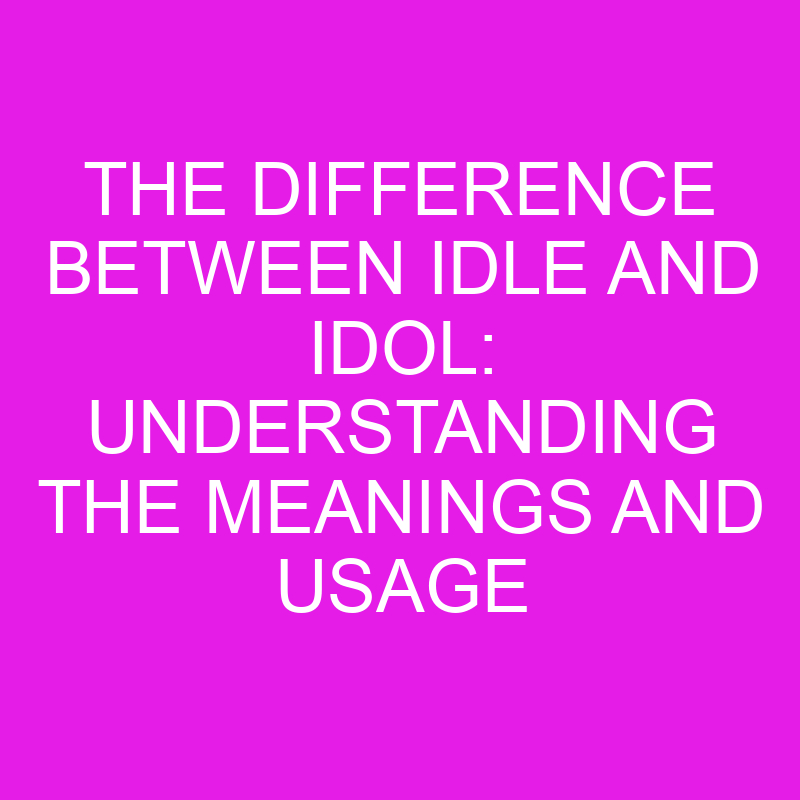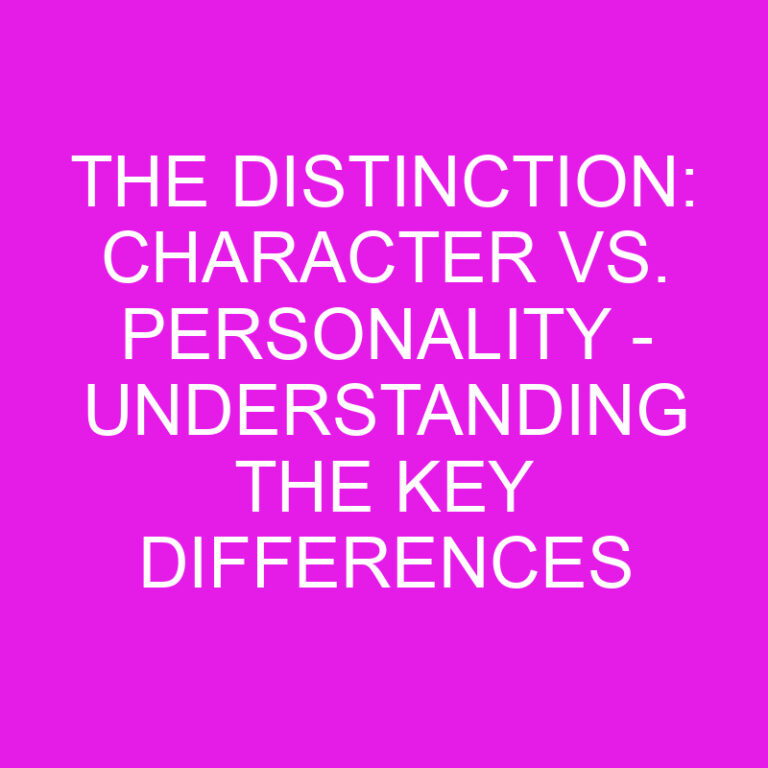
Have you ever wondered about the difference between “idle” and “idol”? These two words may sound similar, but they have completely different meanings. In this article, I’ll break down the distinctions between these commonly confused terms, helping you to use them correctly in your writing and conversations.
Let’s start with “idle.” When something or someone is described as “idle,” it means they are not active or engaged in any meaningful activity. It can refer to a person who is lazy or not working, or to a machine or device that is not in use. On the other hand, an “idol” is something or someone that is worshipped or greatly admired. It can be a religious figure, a celebrity, or even an object that holds significant value or importance to someone.
Now that we have a basic understanding of the difference between “idle” and “idol,” let’s dive deeper into the nuances and explore how these words are used in different contexts. So, buckle up and get ready to unravel the distinctions between these two words that often trip people up.
Post Contents
Key Takeaways
- “Idle” refers to something or someone that is not active or engaged in any meaningful activity, while “idol” refers to something or someone that is greatly admired or worshipped.
- “Idle” can describe lack of activity, lack of engagement in work, and wasted time, and can be used to describe objects, machines, or people.
- Examples of “idle” in different contexts include idle machines, idle time, idle talk, idle hands, and idle curiosity.
- Understanding misconceptions about the word “idle” can help in appropriate usage, such as the misconception that it only applies to people or that it always has a negative connotation.
- “Idol” can refer to celebrities, sports stars, musicians, or objects that are greatly admired or revered.
- Examples of “idol” in different contexts include idols in the entertainment industry, sports idols, religious idols, role models, and pop culture idols.
- Idols have significant cultural and religious significance and can be found in Hinduism, Buddhism, Christianity, indigenous religions, and in society’s cultural context.
What does “idle” mean?
When we talk about the word “idle,” it refers to something or someone that is not active or engaged in any meaningful activity. It often signifies a state of inactivity or laziness. Here are some key points to understand the meaning of “idle”:
- Lack of Activity: When something is described as “idle,” it means that it is not being used or utilized. For example, an idle car is one that is not running or being driven.
- Not Engaged in Work: If someone is referred to as “idle,” it suggests that they are not involved in any work or task. It implies a lack of productivity or a reluctance to put in effort.
- Wasted Time: The word “idle” can also convey a sense of time being wasted or spent in an unproductive manner. It implies a lack of purpose or direction in one’s actions.
It’s important to note that the term “idle” can be used in various contexts, such as describing objects, machines, or even people. Its meaning may vary slightly depending on the specific context in which it is used.
Now that we have a clear understanding of what “idle” means, let’s move on to explore the meaning of the word “idol” in the next section.
Examples of “idle” in different contexts
One of the interesting aspects of the word “idle” is its versatility and applicability to various contexts. Let’s explore a few examples to understand how this word is used.
- Idle machines: In the manufacturing industry, an “idle machine” refers to a piece of equipment that is not in use or not functioning. It could be a production line machine that is temporarily halted due to maintenance or a machine that is not being utilized during non-peak periods. The term “idle” in this context highlights the lack of activity and productivity.
- Idle time: “Idle time” refers to the unproductive or wasted time when someone or something is not engaged in any meaningful activity. For instance, employees might experience idle time when they are waiting for instructions or during slow business periods. Similarly, a computer can have idle time when it is not processing any tasks. The concept of idle time emphasizes the importance of maximizing productivity and minimizing wasted resources.
- Idle talk: This phrase is used to describe frivolous or unnecessary conversation with no specific purpose. When people engage in idle talk, they may be gossiping, engaging in small talk, or simply having a casual conversation that does not contribute meaningfully to the topic at hand. Idle talk can be seen as a distraction or a time-wasting activity.
- Idle hands: The phrase “idle hands” suggests that when someone’s hands are idle, they are not engaged in any kind of work or task. This expression is often used to convey a sense of laziness or lack of ambition. It implies that when people are not occupied with meaningful activities, they may engage in unproductive or even harmful behaviors.
- Idle curiosity: “Idle curiosity” refers to a casual or passing interest in something without any significant intent to pursue further knowledge or understanding. It implies a superficial level of curiosity that does not lead to action or engagement. People may exhibit idle curiosity when they briefly inquire about a topic without any genuine desire to explore it further.
These examples highlight the different ways in which the word “idle” can be used to describe inactivity, wasted time, lack of purpose, or lack of engagement. Understanding these nuances can help us grasp the various contexts in which this word is employed. But before moving on, let’s explore another intriguing term related to “idle”: the word “idol”.
Common misconceptions about the word “idle”
There are some common misconceptions about the word “idle” that can lead to confusion. Let’s clear them up:
- Idle means just being lazy: While it’s true that “idle” can be used to describe laziness or lack of ambition, it has a broader meaning. It can refer to anything that is not active or engaged in any meaningful activity, including objects and machines.
- Idle only applies to people: This is another misconception. “Idle” can be used to describe not just people, but also machines, objects, or even time. It encompasses a range of contexts beyond just human inactivity.
- Idle always has a negative connotation: While “idle” can sometimes imply a negative meaning, such as wasted time or wasted potential, it doesn’t always have a negative connotation. It can also be used in neutral or positive contexts, such as idle curiosity or idle chatter.
- Idle is the same as “inactive”: While “idle” and “inactive” are similar in meaning, they are not exactly the same. “Idle” implies a lack of meaningful activity or purpose, while “inactive” simply means not active.
Understanding these misconceptions can help us use the word “idle” in its appropriate context. Now, let’s move on to exploring the term “idol” and how it differs from “idle”.
What does “idol” mean?
“Idol” is a term that is often associated with religious or spiritual contexts. It typically refers to an object or representation that is worshipped or revered as a deity or symbol of worship. However, the meaning of “idol” extends beyond its religious connotation and can be used in a broader sense.
In a general sense, an “idol” can also refer to a person or thing that is greatly admired, adored, or idolized by others. This can include celebrities, sports stars, musicians, or even fictional characters that have a significant impact on people’s lives.
The term “idol” carries a sense of fervent admiration and devotion. It often implies that the person or object being idolized has a profound influence and holds a special place in the hearts and minds of their followers or fans.
It’s important to note that while “idol” can refer to objects or people, it typically carries a positive connotation. It denotes admiration and respect rather than a negative judgment. However, it can also be used in a more critical sense to describe someone who is blindly worshipped without question or discernment.
Understanding the meaning of “idol” helps us differentiate it from “idle.” While both words may sound similar, they have distinct definitions and implications. In the next section, we will explore the key differences between these two terms and their usage in different contexts.
Examples of “idol” in different contexts
In various contexts, the term “idol” is used to describe a person or thing that is greatly admired or idolized. Here are some examples that illustrate the different ways in which “idol” can be used:
- Entertainment Industry: In the realm of entertainment, we often hear about “idols” who have a massive fan following. These idols can be found in the music, film, or sports industries. Fans admire them for their talent, charisma, and the profound influence they have on their supporters. For instance, an idol in the music industry may have dedicated fans who attend every concert and passionately support their favorite artist.
- Sports: In the world of sports, athletes can also be considered idols. They are admired for their exceptional skills, achievements, and the impact they have on their fans. Sports idols inspire their supporters to pursue their own dreams and emulate their success. For example, a basketball player who consistently delivers outstanding performances on the court may be revered as an idol by fans.
- Religion: In religious contexts, “idol” is often associated with an object or representation that is worshipped or revered. These idols can be statues, icons, or symbols that are believed to embody the divine. Followers of a particular religion express their devotion and admiration by offering prayers and paying homage to these idols as a way to connect with the spiritual realm.
- Role Models: Idols can also be individuals who serve as role models and sources of inspiration. They may possess qualities such as kindness, intelligence, or leadership that make them worthy of admiration. For example, a scientist who has made groundbreaking discoveries in their field and uses their influence to promote positive change can be seen as an idol for aspiring scientists.
- Pop Culture: In popular culture, we often use the term “idol” to refer to celebrities who have a significant impact on society. These idols can be actors, musicians, or social media influencers. They are admired for their talent, style, and the way they shape trends and influence their audience.
Understanding the different contexts in which the term “idol” is used helps us appreciate the varying degrees of admiration, influence, and reverence associated with this word. It is important to note that while idols are often viewed positively, there can also be a critical aspect to idolization when it involves blind devotion or unquestioning admiration.
The significance of idols in various cultures and religions
Idols have played a significant role in various cultures and religions throughout history. These sacred objects or representations hold deep meaning and serve as a focal point for worship and reverence. Let’s explore the significance of idols in different cultural and religious contexts.
1. Hinduism: In Hinduism, idols are central to religious practices. They are considered a physical representation of deities and provide a tangible link between the worshipper and the divine. Devotees offer prayers, make offerings, and seek blessings from the idols, believing that they embody the divine presence.
2. Buddhism: While Buddhism rejects the notion of an eternal soul and the worship of a personal god, idols, or “Buddha statues,” are still used symbolically. They serve as reminders of the qualities and teachings of the Buddha, representing enlightenment, compassion, and mindfulness.
3. Christianity: Although Christianity prohibits the worship of idols, sacred art and images play an important role in the faith. Icons and statues are used to depict scenes from the life of Jesus Christ and other saints, serving as visual aids for prayer and meditation.
4. Indigenous Religions: Many indigenous religions around the world incorporate idols or sacred objects as a way to connect with the spiritual realm. These idols can represent ancestral spirits, natural forces, or mythological beings, and are often used in rituals and ceremonies to honor and communicate with the divine.
5. Cultural Significance: Beyond religious contexts, idols hold cultural significance in various societies. For example, in ancient Egypt, pharaohs were considered divine, and their statues symbolized their power and authority. Similarly, in contemporary popular culture, celebrities and public figures are often idolized by fans, highlighting the broader concept of idols in society.
The significance of idols varies across cultures and religions, but they all share a common thread of reverence and devotion. The powerful symbolism and emotional connection created through idol worship provide a sense of spiritual fulfillment and guidance for believers.
Conclusion
Understanding the difference between “idle” and “idol” is essential for clear communication and avoiding confusion. While “idle” refers to a lack of activity or purpose, “idol” carries a deeper meaning associated with admiration, devotion, and influence.
The term “idol” can be used in various contexts, such as religion, entertainment, sports, and popular culture. It describes someone or something that is greatly admired, often with a fervent devotion. However, it is important to note that “idol” can also be used critically to describe blind worship or excessive admiration.
Throughout history, idols have played a significant role in different cultures and religions. They serve as focal points for worship, reverence, and spiritual connection. Idols symbolize beliefs, values, and emotional connections for believers.
By understanding the nuances between “idle” and “idol,” we can effectively communicate our thoughts and ideas, and appreciate the impact idols have on various aspects of society. So, whether we’re discussing a lack of activity or discussing someone we greatly admire, it’s important to use the correct term and understand its implications.
Frequently Asked Questions
Q: What does the word “idol” mean?
The word “idol” has multiple meanings. It is often associated with religious or spiritual contexts, referring to an object or representation that is worshipped or revered. However, it can also be used more broadly to describe a person or thing that is greatly admired or idolized.
Q: How is “idol” different from “idle”?
While “idol” refers to something or someone that is admired or worshipped, “idle” refers to something or someone that is not active, not in use, or lacking purpose. The words have different meanings and are used in different contexts.
Q: Can “idol” have a negative connotation?
Yes, “idol” can sometimes have a negative connotation when used to describe someone who is blindly worshipped or blindly admired. However, in most cases, “idol” carries a positive connotation of admiration and reverence.
Q: In what contexts can “idol” be used?
“Idol” can be used in various contexts, including the entertainment industry, sports, religion, role models, and pop culture. In each of these contexts, it refers to someone or something that is greatly admired or idolized.
Q: What is the significance of idols in different cultures and religions?
Idols play a significant role in various cultures and religions throughout history. They serve as a focal point for worship, reverence, and spiritual connection. Examples include idols in Hinduism, Buddhism, Christianity, indigenous religions, and cultural contexts. Idols are used symbolically and create an emotional connection for believers.






